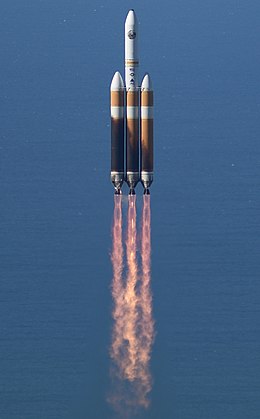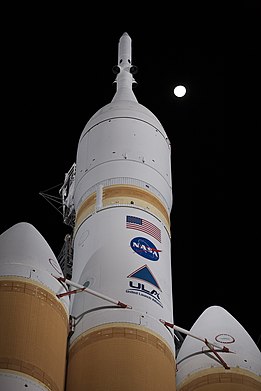Delta IV Heavy
 Delta IV Heavy launches from Vandenberg Air Force Base
| |
| Function | Orbital heavy-lift launch vehicle |
|---|---|
| Manufacturer | United Launch Alliance |
| Country of origin | United States |
| Cost per launch | US$350 million NRO: US$440 million |
| Size | |
| Height | 72 m (236 ft) |
| Diameter | 5 m (16 ft) |
| Width | 15 m (49 ft) |
| Mass | 733,000 kg (1,616,000 lb) |
| Stages | 2+ |
| Capacity | |
| Payload to LEO | |
| Mass | 28,790 kg (63,470 lb) |
| Payload to GTO | |
| Mass | 14,220 kg (31,350 lb) |
| Associated rockets | |
| Family | Delta |
| Comparable | |
| Launch history | |
| Status | Production ended |
| Launch sites | |
| Total launches | 15 |
| Success(es) | 14 |
| Partial failure(s) | 1 |
| First flight | 21 December 2004 (USA-181) |
| Last flight | 22 June 2023 (NROL-68) |
| Type of passengers/cargo | |
| Boosters (CBC) | |
| No. boosters | 2 |
| Height | 40.8 m (134 ft) |
| Diameter | 5.1 m (17 ft) |
| Empty mass | 26,000 kg (57,000 lb) |
| Gross mass | 226,400 kg (499,100 lb) |
| Propellant mass | 200,400 kg (441,800 lb) |
| Powered by | 1 RS-68A |
| Maximum thrust | 3,140 kN (710,000 lbf) |
| Total thrust | 6,280 kN (1,410,000 lbf) |
| Specific impulse |
Sea level: 360 s (3.5 km/s) Vacuum: 412 s (4.04 km/s) |
| Burn time | 242 seconds |
| Propellant | LH2 / LOX |
| First stage (CBC) | |
| Height | 40.8 m (134 ft) |
| Diameter | 5.1 m (17 ft) |
| Gross mass | 226,400 kg (499,100 lb) |
| Propellant mass | 200,400 kg (441,800 lb) |
| Powered by | 1 RS-68A |
| Maximum thrust | 3,140 kN (710,000 lbf) |
| Specific impulse |
Sea level: 360 s (3.5 km/s) Vacuum: 412 s (4.04 km/s) |
| Burn time | 328 seconds |
| Propellant | LH2 / LOX |
| Second stage (DCSS) | |
| Height | 13.7 m (45 ft) |
| Diameter | 5.1 m (17 ft) |
| Gross mass | 30,700 kg (67,700 lb) |
| Propellant mass | 27,220 kg (60,010 lb) |
| Powered by | 1 RL10-B-2 |
| Maximum thrust | 110 kN (25,000 lbf) |
| Specific impulse | 462 s (4.53 km/s) |
| Burn time | 1125 seconds |
| Propellant | LH2 / LOX |
The Delta IV Heavy (Delta 9250H) is an expendable heavy-lift launch vehicle, the largest type of the Delta IV family. It is the world's third highest-capacity launch vehicle in operation, behind NASA's Space Launch System and SpaceX's Falcon Heavy and closely followed by CASC's Long March 5. It is manufactured by United Launch Alliance (ULA) and was first launched in 2004. ULA will retire the Delta IV Heavy in 2024. As of June 2023, one flight remains.
The Delta IV Heavy consists of a central Common Booster Core (CBC), with two additional CBCs as liquid rocket boosters instead of the GEM-60 solid rocket motors used by the Delta IV Medium+ versions. At lift off, all three cores operate at full thrust, and 44 seconds later the center core throttles down to 55% to conserve fuel until booster separation. The two side boosters burn out at 242 seconds after launch and are separated as the core booster throttles back up to full thrust. The core burns out 86 seconds later, and the second stage completes the ascent to orbit.
The launch vehicle uses three RS-68 engines, one in the central core and one in each booster. On the last seconds of countdown, the hydrogen fuel flows through the engines and upwards along the booster body, and after the ignition that hydrogen inflames, making the characteristic fireball and charred look of the booster.
History

The Delta IV line of rockets was developed by Boeing. The program was later transferred to United Launch Alliance. The Delta IV Heavy is the most powerful member of the line, which also includes the smaller Delta IV Medium. The Delta IV Heavy can lift 28,370 kg (62,550 lb) to low Earth orbit and 13,810 kg (30,450 lb) to geostationary transfer orbit (GTO). It is an all liquid-fueled launch vehicle, consisting of an upper stage, one main booster and two strap-on boosters.
The first launch of the Delta IV Heavy on 21 December 2004 carried a boilerplate payload and was a partial failure. Cavitation in the liquid-oxygen propellant lines caused shutdown of both boosters eight seconds early, and the core engine nine seconds early; this resulted in a lower staging velocity for which the second stage was unable to compensate. The payload was left in a lower than intended orbit. Its first operational payload was the DSP-23 satellite, successfully launched in 2007; it was then used to launch a further five visual and electronic reconnaissance satellites for the National Reconnaissance Office (NRO) through 2013.
In December 2014, the Delta IV Heavy was used to launch an un-crewed test flight of the Orion spacecraft, designated Exploration Flight Test 1 (EFT-1). After several delays, the mission was successfully launched at 12:05 UTC on 5 December 2014.
On 12 August 2018, the Delta IV Heavy with an additional Star 48BV third stage was used to launch the Parker Solar Probe into an elliptical heliocentric orbit. In May 2023, the final Delta IV Heavy core and boosters finished construction, officially ending Delta IV production and making way for the Vulcan launch vehicle.
Capabilities
Capacity of the Delta IV Heavy:
- Low Earth orbit (LEO), 200 km × 28.7°: 28,790 kg (63,470 lb)
- Low Earth orbit (ISS), 407 km × 51.6°: 25,980 kg (57,280 lb)
- Geosynchronous transfer orbit (GTO): 14,220 kg (31,350 lb)
- Geosynchronous orbit (GEO): 6,750 kg (14,880 lb)
- Lunar transfer orbit (LTO): 10,000 kg (22,000 lb)
- Mars transfer orbit: 8,000 kg (18,000 lb)
The Delta IV Heavy's total mass at launch is approximately 733,000 kg (1,616,000 lb) and produce around 952,000 kg (2,099,000 lb) of thrust to power the rocket skyward at liftoff.
Launch history
| Flight | Date | Payload | Mass | Launch site | Outcome |
|---|---|---|---|---|---|
| 1 | 21 December 2004 | DemoSat, Sparkie / 3CS-1 and Ralphie / 3CS-2 | ~13,228 pounds (6000 kilograms) | Cape Canaveral, SLC-37B | Partial failure |
| 2 | 11 November 2007 | DSP-23 Defense Support Program | 11,574 pounds (5,250 kilograms) | Cape Canaveral, SLC-37B | Success |
| 3 | 18 January 2009 | Orion 6 / Mentor 4 (USA-202 / NROL-26) | Classified | Cape Canaveral, SLC-37B | Success |
| 4 | 21 November 2010 | Orion 7 / Mentor 5 (USA-223 / NROL-32) | Classified | Cape Canaveral, SLC-37B | Success |
| 5 | 20 January 2011 | KH-11 Kennen 15 (USA-224 / NROL-49) | <37,479 pounds (17,000 kilograms) | Vandenberg, SLC-6 | Success |
| 6 | 29 June 2012 | Orion 8 / Mentor 6 (USA-237 / NROL-15) | Classified | Cape Canaveral, SLC-37B | Success |
| 7 | 26 August 2013 | KH-11 Kennen 16 (USA-245 / NROL-65) | <37,479 pounds (17,000 kilograms) | Vandenberg, SLC-6 | Success |
| 8 | 5 December 2014 | Orion Exploration Flight Test-1 (EFT-1) | 46,297 pounds (21,000 kilograms) | Cape Canaveral, SLC-37B | Success |
| 9 | 11 June 2016 | Orion 9 / Mentor 7 (USA-268 / NROL-37) | Classified | Cape Canaveral, SLC-37B | Success |
| 10 | 12 August 2018 | Parker Solar Probe | 1,510 pounds (685 kilograms) | Cape Canaveral, SLC-37B | Success |
| 11 | 19 January 2019 | NROL-71 | Classified | Vandenberg, SLC-6 | Success |
| 12 | 11 December 2020 | Orion 10 / Mentor 8 (USA-268/ NROL-44) | Classified | Cape Canaveral, SLC-37B | Success |
| 13 | 26 April 2021 | KH-11 Kennen 17 (NROL-82) | Classified | Vandenberg, SLC-6 | Success |
| 14 | 24 September 2022 | KH-11 Kennen 18 (NROL-91) | Classified | Vandenberg, SLC-6 | Success |
| 15 | 22 June 2023 | Orion 11 / Mentor 9 (NROL-68) | Classified | Cape Canaveral, SLC-37B | Success |
Future launches
Missions thirteen through sixteen were announced by the National Reconnaissance Office. For the final five missions (12-16) including modifications, ULA was awarded US$2.2 billion, or US$440 million per launch. This can be compared with the Falcon Heavy launch price of $90M to $150M. As of June 2023, only one remains before ULA retires the Delta IV Heavy.
| Flight | Date | Launch site | Payload | Mass | Orbit | Customer | Launch outcome |
|---|---|---|---|---|---|---|---|
| 16 | 1 March 2024 | CCSFS, SLC-37B | NROL-70 | Classified | GEO | US NRO | Planned |
| Reconnaissance satellite, final flight of the Delta rocket family. | |||||||
Comparable vehicles
Current:
- Long March 5 (geostationary transfer orbit)
- Long March 5B (low Earth orbit)
- Long March 7A (geostationary transfer orbit)
- Falcon Heavy
- Proton-M
- Vulcan Centaur
- Angara A5
In development:
Retired or cancelled:
- Ariane 5 (retired)
- Atlas V Heavy (proposed, never developed)
- Saturn IB (retired)
- Titan III (retired)
- Titan IV (retired)